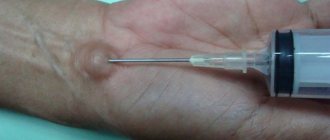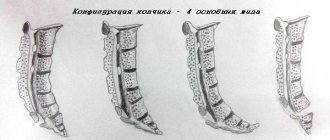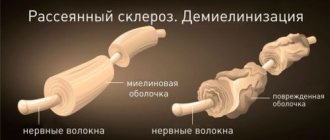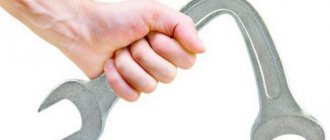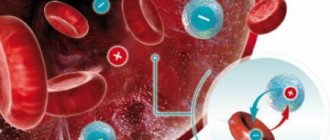After suffering stress or excessive physical activity, young people experience twitching of the hands and fingers, or in extreme cases, the forearms. Symptoms go away on their own with proper rest. It’s a completely different matter when uncontrolled sweeping movements are noticed in old people. This is a sign of the presence of some disease. Let's understand what senile hand tremor is in older people, its causes, and what treatment is necessary.
Physiological and pathological tremor
Very sensitive people cannot bear negative events calmly. They experience severe nervous overexcitation and cannot control their attacks of anger. Indignation and aggression lead to an unpleasant twitching even of the entire body, which goes away after the end of the “outbreak”.
It’s another matter when a citizen is at rest, and his hands are shaking. Or the shaking intensifies during work that requires concentration and attention, for example, threading a needle, sewing a button, writing a letter with a pen. You can use a simple test to determine what type of pathology it is. To do this, you need to stretch your limbs with your palms down. Stand in this position for several minutes. If the twitching has progressed into a phase of severe trembling, then this disease is pathological in nature. In this case, a full examination in a medical facility is advisable.
Causes
There are many reasons why hands shake. Some of them cause physiological tremors: the hands shake due to the influence of some factor.
The main thing is to determine the cause in a timely manner in order to return to a normal lifestyle. The causes are divided into physiological and those that indicate the presence of a disease.
Physiological
As a rule, hands tremble due to the abuse of certain foods. This includes chocolate, tea, coffee. Caffeine increases the tone of blood vessels in both the heart and brain, which can have a detrimental effect on health. It provokes excitement, a person experiences anxiety, hands shake, and the general condition worsens. If you do not overuse these products, hand tremors will not bother you.
The trigger for hand tremor is cigarette abuse. In advanced stages, alcohol tremors occur, usually in the morning. At the same time, not only the hands shake, but the whole body. Symptoms disappear when alcohol is stopped.
Excessive stress, both physical and mental, can cause tremors. This case implies:
- regular rest;
- taking sedatives;
- reduction of physical activity.
Running, swimming, gym - good for health, but in moderation. Many have experienced hand tremors due to anxiety, depression and stress. At the same time, not only your hands, but also your legs can shake. Here you need to take sedatives or even the help of a psychologist.
An unpleasant situation can also arise when a person takes medication for a disease, and at the same time his hands tremble, sleep and activity are disturbed. Tremors are less noticeable when taking medications. When the drug is discontinued, everything will return to normal. Most often this occurs due to taking antidepressants, lithium, psychostimulants, especially in excess dosage.
By limiting these stimuli, tremor will not appear. However, there are a number of diseases that are accompanied by hand tremors. In these cases, this trouble is pathological in nature, and the underlying ailment needs to be treated.
Signal of illness
Hormonal imbalance can also lead to tremors:
- Excess hormones can lead to thyrotoxicosis. Consequently, the patient’s hands will tremble, irritability and nervousness, sudden sweating, rapid pulse, weakness and drowsiness will appear. This is a rather serious disease that requires competent treatment and timely consultation with a doctor.
- Diabetes mellitus is accompanied by weakness, palpitations, and in general, the person is in a semi-fainting state. Many patients fall into a hypoglymic coma, which requires emergency care. The condition is stabilized by consuming carbohydrates (sugar, bread or chocolate).
- Parinsonian tremor - hands shake at rest. As soon as the person himself makes the movement, the trembling decreases or stops altogether. This type is characterized by asymmetrical movements.
- Essential tremor - a person tries to hold his hands at a certain level and position, but at the same time his hands tremble. In this case, it is invisible to others, but when drinking alcohol, the symptoms increase.
- Atactic tremor - appears as a result of contusions, bruises, injuries, concussions of varying degrees, poisoning or the development of sclerosis. The amplitude of the tremor increases when the hand reaches the target. At rest, the hand does not shake.
- Asterixis - large and irregular movements with an outstretched hand. Previously observed in people with hepatic encephalopathy, which is accompanied by cirrhosis of the liver.
- Rhythmic myclonus is characterized by trembling of the hands; this process does not occur at rest. The amplitude of movements can reach up to several centimeters. Accompanies the following serious pathologies: Wilson's disease, multiple sclerosis, as well as micro-strokes, anemia and kidney disease.
Physiological causes of hand tremors in older people
Factors leading to an unpleasant condition include:
- Diseases of the endocrine gland.
- Lack of iron necessary to maintain hemoglobin in the blood.
- Diabetes.
- Kidney problems.
- Liver failure.
- Blockage of blood vessels leading to micro-strokes.
In such cases, to identify the disease and eliminate complications, consultation with specialists and appropriate treatment are necessary.
Possible ailments where limb trembling occurs:
- Parkinson's disease is not uncommon. People over 60 years old suffer from it. The disease can be accompanied by strong sweeping movements of the arms, with an amplitude of up to 5 swings per minute. In a calm state, a slight tremor of the hands is possible. But it happens when the pathology is insignificant or completely absent. Unfortunately, modern medicine has not yet found drugs to completely cure the disease. In 90% of cases, people suffering from Parkinson's become disabled. Therefore, for effective therapy it is necessary to seek help from doctors as early as possible.
- Wilson-Konovalov.
- Multiple sclerosis is also accompanied by large flapping movements.
- Neuroses of varying degrees.
- Senile dementia.
- Hereditary (genetic) diseases. An example is Minor's disease.
- Cancerous tumors in the cerebral cortex.
- Head injuries.
Leave a request for selection of a boarding house
for an elderly person with hand tremors
Onset of symptoms in young people
Doctors identify several reasons why this phenomenon may occur in young people:
- Heredity.
- It cannot be ruled out that a guy or girl may have a state of stress caused by the worries characteristic of adolescence. This is due to the characteristics of a young organism, characterized by increased excitability. Banal tremor of the youthful type, which is also called familial, is characterized by alternating trembling of the hands, gradually moving into the body and legs.
- This phenomenon will be the result of bad habits among young people (drinking alcohol, smoking or taking drugs).
- People with thyroid diseases also suffer from this phenomenon, which is also accompanied by trembling of the tongue when it protrudes.
- Trembling is caused by poisoning of a young body with mercury vapor, which is also typical for older people.
Why the tremor appeared and how to treat it will be best determined by a doctor, so if a tremor occurs in the hands of a young person, he should consult a therapist.
Psychological factors leading to hand tremors in the elderly
Emotional people are more likely to experience this phenomenon. During the experience of fear or fear, grief, or anger, convulsive trembling of the limbs occurs. In addition, it can begin from excessive physical labor, hypothermia, or sun or heatstroke.
There are several other causes of tremor:
- Depressive state. Then you just need to undergo a rehabilitation course with a psychiatrist. He will prescribe antidepressants, which in a month will already give a positive result. A person’s mood improves, anxiety disappears and self-confidence appears.
- Taking some medications may cause side effects.
- Abuse of alcohol, cigarettes, drugs and coffee.
- Intoxication of the body due to poisoning with carbon monoxide, heavy metals and toxic objects.
Why are my hands shaking?
Doctors identify many reasons why trembling may occur.
But it is not always the first sign of a more serious disease. At home, it is possible to determine whether your hands are shaking.
You need to take a piece of paper and place it on your outstretched arms.
Palms should be facing down.
If trembling is expressed in slight twitching of the fingers, then this is normal and can occur in a healthy person, being periodic.
The most common causes of this phenomenon include:
- Overexcitation of the human nervous system or simply chronic fatigue of the body.
- Prolonged stress on the body caused by working with heavy objects (lifting, carrying, etc.).
- A side effect from taking certain medications.
- Hormonal imbalance.
- Disorders of blood sugar in humans.
- Ordinary hysteria or depression against the background of prolonged emotional experiences.
What is limb tremor in the elderly, and why does it happen?
Trembling of fingers, hands, forearms and even the head is an involuntary rapid vibration of these parts of the body, occurring due to muscle contraction. It is caused by a time delay in corrective signals, so movement or maintaining a pose depends on the restructuring of the body. Intensification of symptoms can be due to a nervous breakdown, psychological agitation, overwork, and severe impairment of the nervous system.
General clinical picture
Symptoms associated with hand tremors:
- for an essential type of disorder it is typical that in the later stages of the disease mild cerebellar dysfunctions appear: ataxia, disturbances in coordination of movement, balance when walking;
- the parkinsonian type is accompanied by hypokinesia (limited mobility), postural instability (impaired balance), rigidity (a sharp increase in the tone of anatomical structures);
- the dystonic type is accompanied by a pathological posture in the affected part of the body;
- Holmes tremor is characterized by additional symptoms: rigidity, poor coordination, imbalance, other brainstem symptoms (dizziness, difficulty swallowing, floating movements of the eyeballs);
- cerebellar tremor accompanies coordination impairment, dysmetria (a person cannot hit the target), adiadochokinesis (difficulty performing alternating movements at a fast pace).
Subtypes and symptoms
In medicine, the most common types of disease are:
- Parkinsonian. At rest, old people experience fluctuations from minor twitching to sweeping circular movements. During any activity, symptoms may decrease or disappear altogether.
- Cerebellar (intentional). This type is characterized by a low oscillation frequency, which is how it differs from other types of pathology. Other symptoms include rhythmic oscillation of the head and torso.
- Essential. Caused by genetic predisposition. Manifested by twitching of the head, facial muscles, tongue, vocal cords, mouth and body. Depending on the age of the patient and the duration of the illness, the oscillation frequency can be from 4 to 10 Hz.
- Neuropathic is detected in nervous disorders and is manifested by trembling of the hands.
- Dystonic is associated with varying degrees of dystonia (dysfunction of the autonomic nervous system).
- Accentuated occurs due to intoxication of the body with alcohol, drugs, poisons, mercury, arsenic. Characterized by severe trembling of the hands.
- Rubral is caused by damage to the midbrain. The symptoms are the same as in the previous paragraph.
- Psychogenic is associated with mental illness. Tremors of the limbs can begin suddenly and also stop abruptly.
- Primary orthostatic is a very rare type. It manifests itself when a person suddenly gets up from bed, and weakness appears in the legs. It is difficult for him to stay upright.
- The first scribe. It appears during concentration when performing complex actions.
What it is?
In fact, small hand tremors or tremors, like rhythmic movements of the limbs, or head, or body, can be a feature of physiology and go away on their own. As a rule, such cases are associated with prolonged hand tension and stress.
If the frequency of repetitions of involuntary muscle contractions, and at the same time the intensity, increases, this is a signal that the body is working in the wrong mode. If attention is not paid to the problem in a timely manner, serious pathologies may develop that can seriously reduce the quality of life or even jeopardize its very existence.
Naturally, tremor is a symptom that can occur in a number of diseases; unfortunately, it is impossible to make a diagnosis based on this symptomatic sign alone, but it is definitely worth thinking about and checking yourself. The upper extremities are most often affected by tremors.
How can you determine the magnitude of vibrations at home?
If the trembling of the limbs occurred as a result of a tragedy experienced, emotional, intellectual or physical overload, then no tests are necessary. The phenomenon itself will disappear after proper rest.
But if you have constant trembling, do a simple exercise before contacting a specialist. Take paper and pen. Reproduce a spiral shape on the sheet. If everything is in order, then the edges of the waves will be spherical and smooth. In another case, jagged lines indicate that it is time to get examined at the hospital.
Essential hand tremor
Many people wonder: is essential hand tremor , how to treat it, and what is it? This disease is a hereditary pathology of the central nervous system. As the disease progresses, patients lose their ability to work. Essential hand tremor usually develops in patients over 65 years of age.
When treating the disease, medications such as anticonvulsants, drugs with sedative and relaxing properties, and beta-blockers are used.
In some cases, intramuscular Botox injections are given. Some people who have not previously used botulinum toxin are confused about what it is. Botulinum toxin is a special poison that affects peripheral nerve endings located in the muscles.
Important! All medications must be used under the supervision of a physician, as they cause unwanted side effects. For example, beta blockers may affect heart rate and blood pressure.
How to treat hand tremors in old age
If you notice the consequences of the test in yourself or an elderly relative, then come to an appointment with a neurologist. Based on an examination and an accurate diagnosis, he will offer an individual treatment regimen. It may include: medications, hydrotherapy, surgery, treatment with unconventional methods (bees and leeches).
Operational event
Manipulation is carried out in rare cases when a conservative course has not brought good results. The surgical method involves inserting a graft into the thalamus of the brain. Intervention can occur in a variety of ways and includes:
- Ultrasound ablation. No intracranial access required. Directional waves are used.
- Thalamotomy. The tremor is reduced by temporarily installing a thin wire.
- Gamma knife action (exposure to radiation rays on thalamic tissue).
- Stimulation of deep structures (introduction of thin electrodes deep into the brain).
Treatment with water when an elderly person's hands are shaking
Hydrotherapy is useful not only for sick people, but also for healthy people. Swimming in the pool and in open water gives very good results. In addition, Charcot showers are prescribed. By alternating cold and hot water, spontaneous fluctuations can be significantly reduced.
Diet table
You need to radically change your diet. Exclude from the menu foods that are harmful to the elderly: coffee, chocolate, baked goods, pickles, marinades, smoked foods, fried foods and fast food. Try to get rid of bad habits, stop drinking alcohol and smoking cigarettes. If you are unable to cope with the problem yourself, then seek help from a narcologist. Your desk should have:
- Fermented milk products: cheese, feta cheese, sour cream, cottage cheese, fermented baked milk, kefir and yogurt.
- Rabbit, turkey and chicken meat.
- Beef liver.
- Nuts of all kinds.
- Oatmeal, pearl barley.
- Fresh vegetables and fruits.
- Non-carbonated drinks: herbal teas, dried fruit compotes, smoothies, juices, fruit drinks.
Another option is possible - fasting. But without consulting a doctor, performing such an action is strictly prohibited!
Treatment with bees and leeches if the hands of the elderly are shaking
Apitherapy and hirudotherapy have been used since ancient times. Modern medicine considers these methods outdated. However, so far they have brought positive results. It is not for nothing that beekeepers feel absolutely healthy for a very long time after the end of the season. And leeches have a triple positive effect:
- bloodletting can relieve the circulatory system and cleanse the blood vessels;
- installing them at biologically active points is equivalent to acupuncture;
- The secretions of the salivary glands contain valuable components that improve blood flow.
Saliva contains substances that act as thrombolytics. They dissolve blood clots, reduce blood clotting, saturate it with oxygen, and help reduce swelling. Thanks to the healing properties of bees and leeches, the immune system is stimulated, which, in turn, helps eliminate symptoms.
Treating tremors at home
A reasonable question arises: how to get rid of hand tremors at home on your own? A person needs to limit the consumption of chocolate products, strong tea and coffee, and stop smoking.
Physical activity must be strictly dosed. In some cases, it is necessary to take folk remedies made from valerian or motherwort root.
In difficult situations, a person can be helped by consulting a qualified psychologist.
If your hands shake with anxiety due to iodine deficiency, you need to eat six apple seeds a day or use iodized salt. This will make up for the lack of nutrients. Apple seeds can be dangerous due to their amygdalin content, so you should eat them with caution, not exceeding the recommended amount.
Attention! Fine motor skills of the hands should be developed. To do this, in your free time you should engage in wood carving, cutting out simple figures from paper, and drawing small pictures.
If a person’s hands periodically shake due to overexertion, you can take a contrast shower and perform special physical exercises.
Treatment with drugs for tremors (shaking) of the hands: what tablets are prescribed for tremors in the limbs
The problem can be solved with the help of modern medicines. Our pharmacology produces a number of drugs that help get rid of pathology. The neurologist prescribes a course based on the patient’s age, frequency of fluctuations and time of manifestation of the disease.
Antidepressants
Psychotropic substances affect the level of neurotransmitters (serotonin, dopamine and norepinephrine). Their action is aimed at restoring the nervous system. They improve mood, reduce anxiety, melancholy, fear, restlessness, and irritability. Increase appetite, normalize sleep. Only a psychiatrist can prescribe antidepressants after making an accurate diagnosis. He selects a specific drug and prescribes the dosage. Uncontrolled use of the drug entails complications that threaten human life.
Inhibitors
Tablets for shaking hands (tremor) are prescribed for nervous disorders (essential type). These include Diacarb, Neptazan, Temozolomide. The trouble may be that when eating food, the taste buds will be muffled.
Benzodiazepines
Xanax, Alprazolam, Clonazepam are prescribed in exceptional cases when other medications have not brought a positive result.
Anticonvulsants
They are great for helping with small fluctuations, but in advanced forms of the disease they are useless. "Primidon" is not prescribed to all patients, since it may not be suitable for a particular citizen.
Diagnostic methods
Trembling hands can appear at any age. It characterizes a state of increased nervousness of a person, and possible serious illnesses. To identify the exact cause of tremor, conduct an examination. Diagnosis often begins with a visit to a specialist neurologist, therapist or endocrinologist.
- The doctor's consultation. At the appointment, he checks the functioning of the nervous system. To exclude dysfunction of the tendon reflex, identify muscle tone, determine tissue sensitivity, check motor coordination and the vestibular apparatus.
- Laboratory analysis of blood and urine. Information from tests is necessary to identify diseases of the endocrine system.
- Additional functional tests. They include tasks such as holding a glass filled with water to your lips, standing for a short time with your arms outstretched, writing a phrase or drawing a spiral line.
- In more complex cases, the “rapid” method is used. It includes high-frequency shooting with slow-motion projection of frames.
- Thermograph research. It allows you to record tremor in 3 different planes.
- If necessary, electromyography is performed.
All diagnostic methods, taken together or separately, make it possible to determine the causes of the disease, the degree of tremor, make a diagnosis and prescribe treatment.
Folk remedies
The doctor offers alternative treatment methods to the therapeutic complex:
- Starvation. It helps reduce muscle spasms, mobilizes the work of all organs of the body, and improves immunity. For older people, this method is indicated only under the supervision of a medical professional.
- Treatment with leeches and bees.
In addition, we recommend using decoctions and infusions from alternative medicine:
- If there is a lack of iodine in the body, chew 5-6 apple grains every day.
- Drink 1 tablespoon of propolis tincture three times a day before meals. The duration of the course is one month. Grind 50 g of the ingredient in a blender, pour vodka over the mixture, and place in a dark place for 2 weeks. Then strain and drink in the required dosage.
- Buy ginseng tincture at the pharmacy. 20 drops is the daily intake.
- 4 tbsp. Pour boiling water over motherwort and drink ⅓ glass after two hours.
- Place 1-3 tansy flowers in your mouth, chew, swallow the saliva, and spit out the cake.
- Pour 60 grams of St. John's wort with hot water and place on low heat for 20 minutes. Cover with a lid and leave to cool overnight. Drink 4 times a day before meals.
- Herbal infusion. Take equal quantities of rosehip and cyanosis roots, herbs: motherwort, mint, rosemary, St. John's wort. Add hop cones. 3 tbsp. collection, pour 500 ml of 40% vodka and let it brew for three weeks. Then put the mixture in the refrigerator. Take 2 drops with warm water. The course is at least two months.
You can use any recipe based on the ingredients provided. Just remember that before using them, you need to consult with your doctor. Otherwise, complications may arise that will be difficult to cope with.
Diagnosis and therapy
Making an accurate diagnosis of hand tremors is not easy; this requires a comprehensive study, which may consist of tests, samples, blood tests, fundus examination, blood pressure measurements, thermography, filming, and MRI.
Physiological tremor can occur in any person and be almost unnoticeable to others. Mild and physiological forms usually do not require treatment.
To overcome an unpleasant state, it is enough to know how to relieve stress and drink soothing herbs: lemon balm, chamomile, mint, motherwort, etc.
Treatment of pathological forms of hand tremor is aimed at reducing the intensity of trembling. In the first stages, medications are not prescribed in most cases.
Beta blockers: Propranolol, Obzidan and Anaprilin will help reduce the amplitude of hand tremors in later stages of the disease. If the result is not achieved, then Primidon, Hexamidine, and other anticonvulsants are prescribed.
What to do if the listed drugs do not help and your hands are still shaking - in especially difficult cases, botulinum toxin-A injections are prescribed intramuscularly.
In especially severe cases, when resistant and pharmacological treatment does not help, neurosurgical intervention is used.
Exercises for limbs
Exercises to reduce hand tremors:
- Place your palms together and raise them to eye level - this is the starting position. Take a deep breath. As you exhale, lower one hand half a finger, and squeeze the lowered one with the other hand. While inhaling, return to the starting position. Repeat the cycle 10 times.
- For hysterical or psychogenic tremors, rubbing the palms until the hands become warm helps.
- Strengthen the hands and restore lost control over the muscles of the hands by modeling clay or plasticine, playing musical instruments, and needlework (knitting).
- Card tricks develop coordination of movement and concentration.
ethnoscience
Folk remedies for treating hand tremors
If tremors occur due to nervousness, the following are recommended:
- in the evening, 150 grams of unpeeled oats are boiled in 2 liters of water, the broth is infused at night, in the morning the mixture is filtered and drunk in small portions throughout the day; course – 5 days, in case of relapse the course is repeated.
- soothing teas from heather, valerian, motherwort, mint, lemon balm: 1 tablespoon per 200 ml of water; The decoction is infused and drunk in small portions throughout the day.
- A warm bath with 2 liters of broth and a few drops of essential oil will calm the nervous system and help you relax.
- meditation and relaxation.
It is often difficult to determine a clinical diagnosis for hand tremors, this is explained by:
a variety of somatic and neurological diseases, a symptom of which is trembling;
patterned manifestation of tremor for various causes and mechanisms of occurrence.
You should:
- avoid stressful situations, overwork;
- stop using caffeine, tobacco, alcohol;
- exercise;
- spend active recreation in nature.
Preventive measures
The most important thing in old age is to avoid stressful situations and not take everything to heart. You need to understand that communicating with aggressive people has a bad effect on your quality of life. Also, don't overload yourself with excessive physical work. Alternate it with periods of proper rest.
All older people should follow the following recommendations:
- Due to your age, try to lead an active lifestyle. Take walks alone or with friends in the fresh air. Do some simple sports: swimming in the pool, aerobics, Nordic walking.
- Go to bed on time. Ensure quality sleep: close the curtains, isolate yourself from unnecessary noise and sounds, choose comfortable bedding.
- Avoid drinking alcohol, cigarettes, drugs and coffee.
- Take a course of anti-anxiety medication.
- Follow all doctor's recommendations.
- Review your diet. Include foods containing iodine, potassium, magnesium, iron and calcium.
- Do exercises with a relaxing effect (yoga, meditation, breathing exercises).
Trembling fingers in a newborn
Many parents of newborns may notice that their baby's hands , lips, jaw or chin are shaking. Trembling is divided into two types: physiological and pathological.
Symptoms of the disease
The following symptoms of physiological tremor are distinguished:
- trembling in the fingers usually disappears after a few moments;
- malaise appears after intestinal colic, severe crying, bathing or changing a diaper.
A premature baby's hands or chin shake much more often than a newborn born at term. This is explained by the immaturity of the baby’s nervous system. By three months of life, the problem in most cases disappears.
If there is a pathology, the child not only shakes his hands, chin, legs and lips, but also his head. Over time, the intensity of the twitching increases, and the trembling spreads throughout the body. If these symptoms appear, it is imperative to show the baby to a neurologist.
Constant involuntary movements of the arms, chin and limbs may indicate the presence of serious abnormalities in the newborn: perinatal encephalopathy, high intracranial pressure, increased levels of adrenal hormone in the blood serum.
Diagnostics
It is impossible to determine the cause of tremor the first time; there is no method that will accurately determine the cause.
Several methods are often used for diagnosis:
- Conversation with the patient and collection of anamnesis. The doctor will clarify the onset of attacks, the situations when they occur, and hereditary issues.
- A medical examination clarifies the quality of the nervous reaction, the presence and safety of reflexes.
- Additional examinations, prescribed if necessary, clarify the preservation of cognitive and speech functions.
- Laboratory tests that help clarify the general condition of the body and some internal organs.
- Genetic tests allow you to accurately determine whether a person has a predisposition to the problem.
- MRI is the most powerful and definitive tool for clarifying the situation.
Unfortunately, there is no universal method to determine the cause of tremor. The doctor explains the clinical picture in detail. Sometimes an additional MRI of the brain is performed to exclude secondary causes of the lesion, as well as laboratory and genetic diagnostics if certain types of tremor are suspected.
Classification of tremor by severity
Classification of hand tremor is carried out on various grounds.
The syndrome may be:
- Physiological. This is the norm: hands tremble due to one-time physical or mental overload.
- Pathological, i.e. caused by the course of a chronic disease.
Depending on the causes of occurrence, hand tremors are divided into the following types:
- Motor. Trembling is expressed in situations when a person performs any actions or movements. Once the motor function ends, the tremor may stop or slow down.
- Kinetic. Tremor is observed in the final phase of movement.
- Rest tremor. Trembling appears in a static state, for example, when a limb rests on an object.
- Postural. This tremor is detected when the arms are tense when they are extended upward or horizontally.
- Intentional. Trembling of the hands occurs during purposeful movement of the limb.
Postural
The causes of postural tremor are nervous excitement, alcohol intoxication, hereditary predisposition, and poisoning with toxic substances. Postural tremor is small in scope and noticeable with outstretched arms. If a person tries to calm it down by force of will, then the shaking of the hands only increases.
Intention tremor
It is pathological in nature and is a consequence of a dysfunction of the cerebellum. Unlike the previous type, it differs in large movements of the hands, the amplitude of the swing is very large. The patient experiences difficulty performing a simple exercise: reaching his nose with his finger.
This type of disease is associated with genetic disorders and heredity. An unhealthy lifestyle – smoking, drinking alcohol and other substances – can worsen the course of the disease.
In this case, the appearance of hand tremors is provoked by an acute psycho-emotional state, excessive physical activity, anxiety, and inappropriate diets.
Hand trembling is moderate, muscle tone is not observed. At the first stage, hand tremors appear only during tension, then they can become chronic.
Antidepressants for anxiety-induced tremors
The advisability of taking antidepressants should be determined by a doctor for each individual patient. Antidepressants can be used in people with chronic alcoholism to relieve withdrawal symptoms, which are characterized by severe hand tremors. Also, while taking antidepressants, it is easier to survive difficult life moments. However, self-administration is fraught with serious consequences, since antidepressants affect the production and preservation of neurotransmitters.
Side effects of drugs
Some medications can cause severe intoxication if the required dose is exceeded, abused, self-medicated, or self-extended the therapeutic course. When the body is intoxicated with active substances of drugs, small-scale trembling appears with an irregular character and low-frequency amplitude. Additionally, nausea, vomiting, dehydration, and weakness occur. Treatment consists of discontinuing the drug. If this measure does not help, rinsing followed by symptomatic therapy is required.
Drug treatment for various conditions: treatment regimens, features
The use of medications is the mainstay of treatment for pathological and distressing physiological tremors. Surgical interventions are used in difficult cases.
Physiological tremor
The primary task is to eliminate the provoking factor. If tremors interfere, then propranolol is prescribed as a single dose of 40 mg.
If long-term relief is necessary, for example in responsible positions, propranolol 10 mg is prescribed according to the recommended regimen.
Juvenile tremor
In adolescence, tremor occurs due to the characteristics of the nervous system. The trembling begins at the fingertips, then covers the entire arm, sometimes spreading to the neck. After a short period of time, the attack ends. This condition is inherited. Most often, drug treatment is not required. But in difficult cases, tranquilizers and anticonvulsants are prescribed.
Drug-induced tremor
In this case, it is enough to discontinue the drug that is causing the problem. If this is not possible, then additional therapy is selected to combat tremor.
Tremor during withdrawal syndrome
And in case of one-time alcohol abuse and withdrawal syndrome occurs, hospitalization is recommended to relieve tremor.
When coming out of long periods of drinking alcohol - binge drinking, hospitalization is strictly required.
In a hospital setting, intravenous therapy with beta-blockers, magnesium and potassium preparations, and tranquilizers will be carried out.
Hand tremors due to cerebellar lesions
When this part of the brain is damaged, there is no clear treatment plan. Therapy is selected individually, sometimes by selecting medications. Used: isoniazid, clonazepam, sometimes carbamazepine and propranolol.
If necessary, especially in the presence of a tumor, surgical treatment is performed. Physiotherapy plays an important role in the treatment of cerebellar tremor, since it is often accompanied by muscle hypotonia. Treatment helps maintain normal muscle condition and helps avoid dystrophy.
Endocrine system diseases
If tremors are dependent on hormonal levels, it is often enough to correct it and treat the endocrine system. If the problem is hyperfunction of the thyroid gland, then it is necessary to treat it: the use of drugs to reduce its activity, in extreme cases, surgical intervention is performed.
If you have type 2 diabetes, it is necessary to reduce blood sugar levels with the help of diet and specialized medications.
Parkinsonian tremor
If you have a Parkinson's diagnosis, various medications may be prescribed:
- biperiden;
- trihexyphenidyl;
- pramipexole;
- ropinirole
If this therapy does not have an effect, clozapine or propranolol are prescribed. If drug treatment is ineffective, surgical treatment is prescribed. Electrical stimulation of certain parts of the brain or destruction of the nuclei responsible for tremor is performed.
Why are your hands shaking?
Hyperkinesis of the arms, legs, chin or the whole body has certain causes.
Physiological factors of trembling are:
- Senile (cyanotic, functional tremor). People over 50–60 years old have shaking hands due to stress and severe nervous excitement. The nervous system in older people does not fully perform its functions; impulses have low conductivity. As a result, during sharp fluctuations in the emotional background, small tremors occur, most often only in the fingers or hands.
- Drinking alcohol. Alcohol-containing drinks cause intoxication throughout the body and destroy brain neurons. When ethanol is decomposed by the liver in alcoholics, acetaldehyde is released, which depresses the cerebellum. As a result, balance is disturbed, often - tremors of the upper limbs, fingers, and head. Muscle tone decreases, the interaction of motor nerves and inhibitory function is disrupted. Drugs act similarly. Tremors may occur from too much coffee.
- Diets, long fasting. During acute hunger, more often in the morning, the sugar level drops sharply and hypoglycemia occurs. With a deficiency of glucose in the blood, pallor, sweating, palpitations, anxiety, irritability, dizziness, and trembling hands are expressed.
- Excitement. With high emotional overload and stress, the central nervous system is under tension and tremors occur. This trembling goes away as soon as the person calms down. More often it occurs in people who are young, impressionable, and have a hysterical character.
- Poisoning, especially mercury. This tremor begins in a calm state and intensifies with movement. First the face suffers, then the limbs. When mercury vapor enters the lungs, it enters the bloodstream and causes intoxication. A malfunction occurs in all systems, especially the central nervous system.
Tremors associated with nervousness or old age are considered harmless.
Tremors during pregnancy often occur in the first trimester. The causes of this condition are heart disease, central nervous system, rheumatism, aggravated by fluctuations in hormone levels.
Pathological reasons:
- Impaired cerebral circulation due to vascular atherosclerosis. When they narrow or are completely blocked, the volume of oxygen supply is reduced, and atherosclerotic plaques develop. The functionality of the central nervous system is impaired due to asphyxia, neurons do not perform their functions. Trembling is more often expressed in the cerebral form of atherosclerosis.
- Parkinson's disease. Rest tremor from 4 to 6 Hz in the hands (as it progresses - in the elbows, shoulder joint) occurs due to destruction processes in the brain area. The functioning of nerve cells and metabolic processes is disrupted.
- Traumatic brain injuries. Hand trembling often accompanies a concussion. Tremor in this case is caused by damage to blood vessels and other structures, and impaired conduction of impulses.
- Minor's disease. Pathology of the central nervous system most often affects patients over 55–60 years of age. It is inherited, the cause of development is a dominant mutation in the 2nd or 3rd chromosomes. Moreover, from generation to generation the severity of the disease increases.
- Thyrotoxicosis. Muscle weakness and tremors of the limbs, voices, and internal trembling in advanced forms of the disease occur against the background of damage to the anterior horns of the spinal cord.
- Cerebrovascular accident. Develops against the background of hemorrhagic and ischemic strokes. In the first case, rupture of the vessel walls causes hemorrhage into neighboring tissues or the brain, in the second, blood clots in the vessels block the delivery of oxygen to the brain. This impairs coordination, causing tremors in the hands and body.
- Multiple sclerosis. Foci of destruction of myelin, which is the main protein of nerve cells, are identified in the brain. Against this background, the functionality of the central nervous system is impaired.
- Tumors, abscesses in the cerebellum. When the structure of the cerebellum and the connections between them degenerate, an intentional type of tremor occurs.
- A group of degenerative diseases of unspecified etiology. Stryonigral and olivopontocerebellar degeneration causes tissue death in the cerebellum and brain.
- Wilson-Konovalov syndrome. This disease, inherited, disrupts copper metabolism and damages the structure of the brain.
- Liver failure. Hepatic encephalopathy in the penultimate stage (before the onset of hepatic coma) leads to severe intoxication of the entire body, which disrupts brain activity. Here the tremor is called asterixis.
Liver failure can cause tremors due to brain problems
This syndrome does not affect life expectancy, but significantly worsens its quality.
General information
This disorder is one of the most common. Often members of the same family suffer from tremors. It can be relatively mild or very severe and malignant. Muscles can contract quite sharply. Palpitations, sweating, muscle pain, weakness, etc. occur.
It's not just adults who suffer from tremors. Children also sometimes experience this phenomenon, but it happens much less frequently. Intrauterine tremor also occurs. Most often, tremor in children is associated with a hereditary predisposition or trauma, including birth. It is important for parents to see the pathology as soon as it appears. Then the treatment will bring maximum effect.
Tremor may appear suddenly, but the disease that caused it takes a long time to develop. The risk group is older people. Among them is the highest percentage of cases. In the elderly, degenerative processes of the brain progress quite strongly. The first symptom is slight trembling when exerting yourself or changing posture. It is older people who most often suffer from Parkinson's syndrome. They experience a decrease in mental activity, involuntary trembling of the limbs and face. Over time, the shaking intensifies and reaches its peak. Degenerative processes can develop rapidly. The structure of brain tissue changes. Tachycardia may occur.
Traumatic brain injury
When the cerebellum of the brain is injured, the functioning of the musculoskeletal system is certainly disrupted, since this center is responsible for coordination of movements and muscle tone. The cause is traumatic brain injury.
Injuries to the cerebellum can affect the balance in thermoregulation.
Symptoms:
- rapid fatigue;
- inability to touch the tip of the nose with a finger when eyes are closed.
Trembling - mild or severe, and occurs when straining or trying to hold your hands. At rest, the limbs do not shake. Additional signs:
- decreased muscle tone;
- sweating;
- lethargy, disobedience of the body;
- disorientation with closed eyes, manifested by the inability to point a finger at a certain part of the body;
- fatigue from simple exercises, especially in the evening.
Another cause of brain center muscle activity is multiple sclerosis.
"Pantogam": a nootropic drug with a long-term effect
Taking Pantogam for tremor is advisable if the condition is triggered by stress. There are two forms of release of the drug - syrup and tablets. The syrup is usually prescribed to children aged six months and older. while taking Pantogam, the ability to learn increases, memory improves, and a person becomes more positive. Irritability, suspiciousness, and anxiety go away.
The main active ingredient is hopantenic acid. This substance began to be used back in the Soviet years, and it has established itself as a relatively safe remedy for a number of neurological pathologies. Hopanthenic acid exhibits moderate anticonvulsant and nootropic activity, increases the brain's resistance to toxic effects during hypoxia of various origins. The drug is prescribed to both elderly people and young children for various types of neurological disorders, decreased learning ability, and developmental delays.
"Pantogam" is relatively rarely used as a drug for hand tremors. However, in complex therapy it is prescribed for many neurological disorders. Pantogam has a significant advantage: the effect lasts for about a month from the moment of discontinuation. This is one of the few drugs with a truly prolonged effect. In addition, Pantogam can be purchased at a pharmacy without a doctor's prescription.
Source
"Atarax": instructions for use
You may be interested in: Calcium gluconate and alcohol: compatibility, possible consequences, reviews
"Atarax" is a tranquilizer, quite often used as tablets for hand tremors. The main active ingredient is hydroxyzine hydrochloride. Doctors prescribe Atarax as a sedative for children aged three years and older. Atarax can also be used as part of a complex treatment for hand tremors in older people. You can purchase the drug at any pharmacy if you have a prescription from a doctor.
Reviews from patients report that sleep improves while taking it. Anxiety and suspiciousness become less or disappear completely. As a rule, Atarax is rarely prescribed as an independent remedy; it is usually used as part of a complex treatment of psychosomatic disorders or neurological diseases.
How to determine the level of trembling
The specificity of the disease allows the presence of tremors to be determined visually.
If you suspect tremor, you can perform a simple test yourself. Draw a spiral on a piece of paper. If the lines are straight, without jagged edges, there is no danger. Otherwise, you should consult a doctor to conduct a detailed examination and identify the causes that led to impaired motor function.
For the purity of the experiment, experts advise not to limit yourself to one experiment, but to conduct the test several times with an interval of 1-2 weeks. You should also pay attention to the condition of the person in which the study is being conducted. This could be rest, after physical activity, after emotional excitement, etc. If the results of these tests are available, it will be easier for the doctor to diagnose the pathology.
There are a few other simple actions that can be a red flag.
- Bring a cup of water to your mouth. If this is difficult to do and the contents spill, then there is a problem.
- A test that almost everyone knows. Stretch your arms forward and hold them in this position for several seconds. If this is not difficult and the upper limbs are calm, then there is no cause for concern.
Another article on the topic: Popular reasons: why alcoholics’ hands shake
It is not difficult to carry out such control checks on your own and you can observe the results without appropriate education.
Doctors are studying not only the nature of the appearance, but the tremor itself. Oscillatory movements can be slow or fast. In the first case, the frequency is 3-5 Hz, in the second – 6-12 Hz.
The direction of movement is vertical and horizontal, more simply they are called “yes-yes” and “no-no”, respectively.
Such gestures are mainly characteristic of patients suffering from alcoholic tremors. In Parkinson's disease, movements occur like "rolling pills" or "counting coins."
During the initial examination, the doctor easily determines the presence of tremor. To do this, it is enough to conduct a visual examination of the patient, since the specificity of the symptom is obvious and clearly expressed.
For a more detailed study of the patient’s condition and diagnosis, the doctor studies the person’s lifestyle and heredity.
A brain study is being carried out. On a note! Only on the basis of comparison and study of all the facts is it possible to correctly diagnose the disease.
Treatment
Treatment of tremor depends on what form the patient is experiencing and how severe it is. If it is mild, it is enough to prescribe relaxing medications or techniques. Stressful situations have a detrimental effect on the body. They cause weakness, tremors, psychosomatic disorders, and insomnia may occur. Stress must be eliminated. Relaxing baths with the addition of herbs, essential oils, breathing exercises, and yoga are often prescribed.
If simple methods do not help, sedative medications are prescribed. They can be either natural or synthetic. It is extremely important to determine whether the trembling is malignant in nature. If the cause of the disease is a tumor, it must be treated immediately. Therapy must be comprehensive and targeted.
It happens that a patient does not suspect for a long time that a malignant tumor is growing in him. Many people simply ignore the body’s first signals. And this is their fatal mistake. Only when the person really starts to shake does he go to the clinic.
If the patient suffers from severe tremor, which is practically not relieved by sedatives, potent drugs are used. These are most often beta blockers. They block some nerve impulses and prevent pathologically active vibration.
When treating, it is important to get rid of the root cause.
The doctor must individually select the dose of potent drugs. Sometimes an extremely small dose can provide significant relief. The amplitude of the tremor noticeably decreases, and clinical manifestations quickly disappear with systemic treatment.
When treating essential type tremor, β-adrenergic receptor antagonists, primidone, and benzodiazepines are prescribed. These drugs can cause tolerance, so neurologists try to prescribe them strictly according to indications, when not only the head and limbs are shaking, but also the torso.
They may also prescribe medications that will help you sleep and eliminate insomnia.
But if the cause of trembling is pathological changes in the cerebellum, medications practically do not help, and things get worse. Sometimes primidone and clonazepam alleviate the condition a little.
For severe cerebellar tremor, surgical methods are used: stimulation of the thalamus, thalamotomy. Now these methods are very common in Europe and the USA. They have proven their effectiveness.
If the cause is multiple sclerosis, hormones may be prescribed.
If the thyroid gland produces excess hormones, medications will be required to reduce their amount.
Tumors and abscesses are removed surgically.
If the reason lies in problems with the liver or kidneys, a transplant or hemodialysis may be required.
In developed countries, the method of deep brain stimulation is used. Electrodes are implanted directly into it. Their task is to suppress or stimulate individual areas that lead to trembling or loss of coordination of movements. Now this method requires improvement. It can cause fainting, numbness, swelling, and a feeling of heaviness. Stimulation is indicated for severe forms of epilepsy and Parkinson's disease.
In addition to the need to treat the underlying disease that provoked the tremor, the intensity of the tremor itself should be reduced. Patients are very worried about this condition. They experience awkwardness, fear, avoid crowded places and contact with others. They feel that they are becoming a burden to loved ones, they experience a feeling of self-pity and resentment. They often experience depression and suicidal tendencies. It is important that close people support the patient not only physically, but also emotionally, and create a positive mood. We need to try to make a person forget about his illness at least for a while.
Causes and treatment of head shaking in adults and children
Such exercises help not only with alcoholic tremors, but also with tremors caused by other reasons.
Hand tremor is a state of trembling of the hands, which can be either short-term or permanent, symmetrical and one-sided, pronounced and erased, with a high amplitude and frequency of trembling and with a low one, dependent on volitional effort and not subject to it.
Under normal conditions, with the correct development of the child, most often after reaching the age of one year, hand tremors in babies disappear. Otherwise, observation by a pediatric neurologist and subsequent treatment are required.
Useful material on the topic: “Hand tremors, causes, treatment, medications, list of medications” with a complete description from professionals in a language that people can understand.
